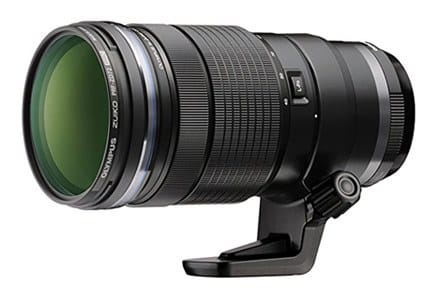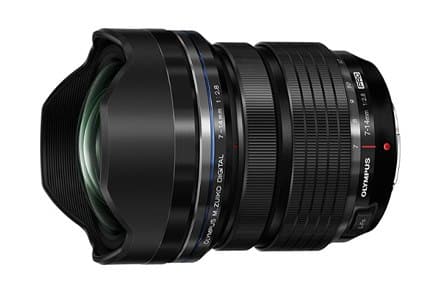Olympus cameras are excellent for wildlife photography due to their small sensor and compact size.
For wildlife and birds, you want a telephoto lens that will get you extremely close to your subject. Sometimes, you can’t physically get closer, and in such moments you’ll appreciate every single millimeter.
Below, we’ll dive deeper into what makes a lens good for wildlife, but first let’s check out what Olympus lenses we picked that give you the most for your money.
Table of Contents
ToggleBest Olympus Wildlife & Birds Lenses:
Olympus M. Zuiko 40-150mm f/2.8 PRO
Olympus M. Zuiko 40-150mm f/4-5.6 R
Olympus M. Zuiko 300mm f/4 PRO IS
If you decide to buy anything after clicking on our Amazon links, you automatically support us. It’s what allows us to write guides such as this one.
What’s Important for Wildlife & Bird Photography?

Here are the 6 most important factors that make a good wildlife lens. We focused on these points when selecting the lenses for this guide.
Auto Focus – The lens needs to have fast and reliable auto focus. While this also depends on the camera you use, Olympus’ latest mirrorless models have AF systems that can handle wildlife and action very well. Animals are constantly on the go, and even when they’re still you still need a lens that can quickly and accurately acquire focus.
Focal Length – The longer the lens, the better it is for wildlife/birds. Most of the time, you can’t get too close to the animal, which is where having the most reach helps the most. Anything over 70mm is an absolute must, whereas 200mm+ is necessary for either small animals, or animals that are really far away. Olympus cameras have an MFT sensor with 2x crop factor, so your lenses act as if they are 2x longer (for example, the 300mm lens we talk about below is equivalent to a 600mm lens on a full frame camera). If you don’t understand this, don’t worry, we already selected the best lenses.
Aperture – Olympus doesn’t have a lot of telephoto lenses available, so there’s not much to choose when it comes to the aperture available. The only f/2.8 zoom is the 40-150mm, and while it’s excellent for wildlife and shooting in low light, you might find it a bit too short for smaller birds. Big animals, zoo etc., all of this is perfectly fine! For shooting outdoors, f/4 – 5.6 is good.
Weight & Size – Don’t forget that telephoto lenses are the heaviest of all. A tripod, or at least a monopod, is a must if you want to shoot for hours.
Image Stabilization – IS is nice to have, but useless in 99% of wildlife situations. IS only helps when your subject is still! Since Olympus puts IS into the camera body, you have nothing to worry about here.
Weather-Resistant – Many Olympus lenses are weather-resistant which means it’s much much harder for dust, water, or any other particle to get in the actual lens. Now just because a lens isn’t sealed, it doesn’t mean a little bit of rain or dust will damage. It simply means you don’t have to worry that much when shooting in difficult weather conditions. The two more expensive lenses on this list are completely weather sealed.
For more information about what you need to consider before you get a lens read our guide on How to Select a Wildlife Lens and check out our tips on photographing wildlife.
Olympus M. Zuiko 40-150mm f/2.8 PRO

The Olympus M. Zuiko Digital ED 40-15mm f/2.8 PRO is an obvious choice for portraiture, stage, sports and wildlife photography. With a constant aperture of f/2.8 at all zoom settings, this a fantastic solution for photographers who frequently need to shoot in low light but who don’t wish to compromise on either portability or image quality.
Equivalent to an 80 to 300mm lens in the 35mm format, the 40-150mm f/2.8 PRO allows you to get right into the heart of the action. And super fast autofocus means you’re unlikely to miss a shot when you do. Present, too, is the ever popular AF-MF clutch ring, allowing you to quickly switch between focus modes while shooting.
The lens is also very well suited to producing portraits, with beautiful circular bokeh backgrounds, and at a wide range of focal distance settings. Olympus’s ZERO lens coating keeps flare and ghosting well contained, and purple fringing is minimal. Image sharpness at the corners is excellent, while at the center it’s outstanding.
The sturdily built lens barrel features a user-assignable custom function button, and a twist-and-slide extendable lens hood. What’s more, as it’s splashproof, freezeproof, and dust proof, this is a lens you can rely on. This is a lens you buy and use forever, for anything; a true workhorse.
You can buy it at Amazon or see more reviews here.
Olympus M. Zuiko 40-150mm f/4-5.6 R

Want a telephoto lens under $150? With fast autofocus and excellent resolution for the low price, the Olympus M. Zuiko Digital ED 40-150mm f/4-5.6 R zoom lens makes for a much more affordable alternative to the brand’s 40-150mm f/2.8 PRO lens. Offering coverage equivalent to 80-300mm (35mm format), this is a great lens for isolating a subject against a background, or for capturing action from a distance. It will be of interest to sports and nature enthusiasts, as well as portrait and performing arts photographers. Similarly, silent autofocus means it’s an equally good choice for video.
There’s no flare, purple fringing, or other chromatic aberrations, and in this respect the budget 40-150mm actually stands up very well when compared to even quite expensive Zuiko lenses. Image sharpness towards the center of the frame is also excellent. However, corners are notably softer than with top of the range Olympus glass. Likewise, if smooth rendering of defocussed areas is a priority, you’ll need to consider other options: bokeh is harsh, with noticeable double-edging.
While the f/4-5.6 R may be at the budget end of Olympus’s telephoto range, optically it holds up well and is conveniently light and compact. Nonetheless, build quality is clearly not on a par with that of its PRO series cousins. Likewise, for those who do a lot of low-light shooting, the constant aperture f/2.8 PRO will be a much more practical choice than the relatively gloomy maximum aperture of f/4-5.6 that this lens can muster.
You can buy it at Amazon or see more reviews here.
Olympus M. Zuiko 300mm f/4 PRO IS

The Olympus M. Zuiko Digital ED 300mm f/4 IS PRO is the first Olympus interchangeable lens for the Micro Four Thirds format to include on-board (as opposed to in-camera) image stabilization. A focal length of 300mm is equivalent 600mm on a full frame camera, so that’s some serious magnification. Combine all this with high-speed precision AF, and excellent image quality, and it’s obvious that this lens will be a great choice for handheld action shooting – such as in sports or wildlife photography.
Traditionally, telephotos have always been prone to aberrations and “color bleeding.” With the 300m f/4 IS PRO, Olympus has worked hard to keep these issues to a minimum. This has been achieved by using extra-low dispersion and extra-high refractive lens elements. Additionally, use of Z Coating Nano technology also makes for a much sharper image.
Closest focusing distance is 115 cm from the end of the lens, meaning that this can also double up for shooting detailed close-ups or headshots with a totally blurred background. Although 300mm is a lot of telephoto capability, the lens is surprisingly slimline and lightweight, weighing only 1270 g. It’s also hermetically-sealed against dust, splashes and freezing temperatures, so you can take the lens to the extreme, safe in the knowledge that it’s up to the challenge. Weather sealing is expected at this price range!
And if 300mm of magnification doesn’t bring you close enough to the action, this lens becomes a super-telephoto with the addition of a converter, offering the equivalent of a 840mm lens in 35mm format.
You can buy it at Amazon or see more reviews here.
Our Most Recommended Wildlife Lenses
Olympus M. Zuiko 40-150mm f/2.8 PRO
Olympus M. Zuiko 40-150mm f/4-5.6 R
Olympus M. Zuiko 300mm f/4 PRO IS
Here is an excellent article on using Olympus gear for wildlife photography
Related Articles
Best Olympus Lenses for Landscape in 2022
Micro Four Thirds cameras are ideal for landscape and traveling, due to their compact size and weight. In this guide,...
Read MoreFirst and foremost, I’m a husband and father. Then professionally I’m photographer, designer, blogger, and Esty store owner. My homebase is near the stunning Wasatch mountains in Utah but I love traveling with my family as part of our homeschooling journey. I also love teaching and helping out others. My faith is one of the biggest aspects of my life and brings be a consistent joy that I haven’t found in anything else. My main blog is BestPhotographyGear.com and I strive to make photography simple for anyone looking to learn or find gear for their individual needs. By nature, I like to study, research, and analyze things and I use that help provide the best advice and reviews I can.


